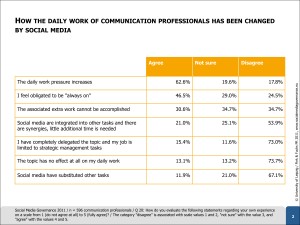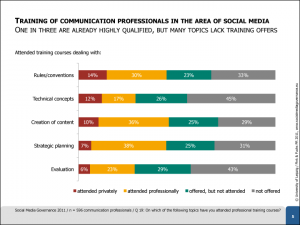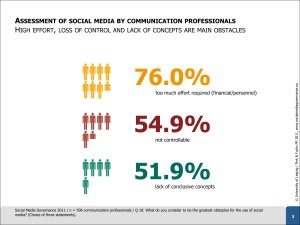Expertise, Structures and Strategies of Companies, Governmental Institutions and Non-Profit Organizations communicating on the Social Web
Klicken Sie auf den unteren Button, um den Inhalt von www.slideshare.net zu laden.
Overview:
- Social media increasingly present in everyday work
- Lack of dedicated skills
- Strategies and responsibilities for social media
- Governance structure emerging
- Recommendations for the practice of corporate communications
- About the study
- To the previous study “Social Media Governance 2010”
Despite growing investments in and increased use of social media, many companies, non-profit organizations, governmental institutions and associations are far from utilizing the full potential of these communication channels. This is revealed by the study “Social Media Governance 2011”, a joint research project organized by the University of Leipzig, pressesprecher magazine, and Fink & Fuchs Public Relations in Germany. The study was conducted for the second time this year, following a pilot study in 2010. A total of 596 corporate communication managers in Germany, Austria and Switzerland were surveyed.
The study investigated the status quo of Social Media Governance, i.e. the status of regulatory frameworks for the strategic management of social media activities in organizations, identified the parameters and prerequisites for communicating on the social web, and examined the associated changes in the daily work and the required level of expertise. During the past twelve months, the number of organizations actively applying social media within their communications increased from 54.3 to 71.3 percent. Despite this substantial increase, the development falls short of the expectations uttered in 2010, according to which eight in ten PR departments were expected to be active in this area already. 28.7 percent of the surveyed professionals are not active on the social web. The study also found that the organizational structures required for social media have improved, mainly due to the considerably increased commitment of top management (48 percent).
However, currently no more than one-third of surveyed organizations have dedicated human resources, guidelines, training programs or monitoring tools for social media. Not more than 15 percent have implemented key performance indicators for measuring success or dedicated social media budgets. The daily pressure generated by social media and growing experience in the area creates a more critical opinion of the development. As a result, only one-third of participants considered their own organization to be well equipped for social media.
Social media increasingly present in everyday work
 Two-third of surveyed PR professionals regularly use online communities such as Facebook, LinkedIn or SlideShare for professional purposes. Private use even stands at 71 percent, which is 100 percent above the average of the entire population found by representative studies. Communication professionals have also become intensive users of video portals (55 percent), Twitter (34 percent) and Blogs (32 percent). At the same time, the time budgets spent for communicating on the social web are increasing. The study found that nearly half of the communication professionals spend several hours per week on content management, dialogue with stakeholders, network creation or conceptual work and strategy development. The high proportion of planning and development in particular is likely to be due to the novelty of the topic and the lack of routine. The time pressure and the growing amount of information around the clock increase the everyday work load and often cause a feeling of having to be “always on”. One-third of the respondents believed that this extra effort cannot be managed. Only 21 percent believed that they are in control of the extra effort required by social media through synergies and the integration of social media in other tasks.
Two-third of surveyed PR professionals regularly use online communities such as Facebook, LinkedIn or SlideShare for professional purposes. Private use even stands at 71 percent, which is 100 percent above the average of the entire population found by representative studies. Communication professionals have also become intensive users of video portals (55 percent), Twitter (34 percent) and Blogs (32 percent). At the same time, the time budgets spent for communicating on the social web are increasing. The study found that nearly half of the communication professionals spend several hours per week on content management, dialogue with stakeholders, network creation or conceptual work and strategy development. The high proportion of planning and development in particular is likely to be due to the novelty of the topic and the lack of routine. The time pressure and the growing amount of information around the clock increase the everyday work load and often cause a feeling of having to be “always on”. One-third of the respondents believed that this extra effort cannot be managed. Only 21 percent believed that they are in control of the extra effort required by social media through synergies and the integration of social media in other tasks.
12 percent of the respondents have substituted other tasks via social media. Consequently, communication managers consider the major obstacles to the professional use of social media to be the high effort in terms of finances and personnel (76 percent), and the previously stated loss of control (55 percent) and lack of conclusive concepts (52 percent). As the respondents’ personal expertise level increased and governance structures in organizations were more clearly defined, these points were raised less and synergies utilized more frequently. Reversely, this means that expertise level and Social Media Governance are important drivers of success for the long-term establishment of social media in corporate communications.
Lack of dedicated skills
 Calculated from ten individual indicators, the social media skill index has increased further during the past twelve months. 22.8 percent of surveyed PR professionals have gained high expertise levels (plus 6 percentage points) and 45.5 percent (plus 3.6) possess average skills. Of the respondents, 31.7 percent (minus 9.6) described their expertise level as low. Familiarity with the social media landscape, communication style, conducting dialogues on the web, and legal frameworks are more prevalent than before. At the same time, there is a continued lack of experience in the areas of strategy development, evaluation, and community management, the core skills required to fully utilize the potentials of the social web. Within governmental institutions, political institutions and associations, the expertise level is significantly lower than among companies and non-profit organizations. Although the structural change of PR through social media has been discussed for years, less than 50 percent of the respondents have attended pertinent training courses.
Calculated from ten individual indicators, the social media skill index has increased further during the past twelve months. 22.8 percent of surveyed PR professionals have gained high expertise levels (plus 6 percentage points) and 45.5 percent (plus 3.6) possess average skills. Of the respondents, 31.7 percent (minus 9.6) described their expertise level as low. Familiarity with the social media landscape, communication style, conducting dialogues on the web, and legal frameworks are more prevalent than before. At the same time, there is a continued lack of experience in the areas of strategy development, evaluation, and community management, the core skills required to fully utilize the potentials of the social web. Within governmental institutions, political institutions and associations, the expertise level is significantly lower than among companies and non-profit organizations. Although the structural change of PR through social media has been discussed for years, less than 50 percent of the respondents have attended pertinent training courses.
Strategies and responsibilities for Social Media Governance
Currently, 74 percent of respondents report that their organizations have implemented social media strategies for corporate communications and PR. However, in practical terms, these are usually limited to individual social media platforms such as Facebook pages or Twitter accounts. Only one in five organizations has a comprehensive strategy for social media communications across the entire corporation or for cross-platform campaigns. The greatest backlog is in the area of evaluation – only nine percent have clearly formulated concepts in this regard.
The most frequently unanswered question is usually how different departments collaborate in the area of social media and who is responsible. One in four respondents indicated that all departments work independently, that there is loose collaboration, or that all employees are allowed to communicate freely and independently. In 61.5 percent of all organizations, a specific department is centrally responsible for social media communication. A cross-departmental social media board has currently only been set up at 11.5 percent of all organizations. Such a structured solution can significantly facilitate the bundling of competencies, the coordination of measures, and the utilization of available potentials.
Governance structure emerging
The Social Media Governance pilot study of last year revealed that the establishment of social media in communication management can be significantly advanced by suitable structures such as guidelines, clear criteria for evaluating success, dedicated human and financial resources, training programs, and a supportive corporate culture. The current study confirms the positive correlation between regulatory frameworks, staff expertise, social media strategies and the actual degree of organizational activities on the social web. The index values of nearly all dimensions developed positively. Today, PR departments use on average seven social media applications, while last year this figure stood at three. Above average development was recorded for technical prerequisites, social media guidelines and – most importantly – top management support.
However, a more in-depth analysis of governance structures shows a much lower development progress of social media communication as that indicated by the euphoric statements of many advocates. It seems that the respondents are rather disillusioned when it comes to assessing the cultural “connectivity” of their own organizations to the principles of the social web, such as the readiness of companies for dialogs that are increasingly demanded by stakeholders. Just under one-third of respondents, seven percentage points less than last year, described their own organization as having a participative and dialogue-oriented corporate culture. At 14 percent, the continued limited prevalence of key figures for monitoring success is noteworthy. In the previous year, 32 percent had announced their introduction by the end of 2010. Since there continues to be a lack of generally recognized and practical indicators for social media communications, the current forecast that four in ten organizations will implement such structures by December seems too optimistic.
Recommendations for the practice of corporate communications
The social web has entered organizations and in particular corporate communications. An increasing number of platforms are being utilized and the growing commitment of top management results in investments in Governance structures for social Media. However, there remains a need for action in five central areas:
- Systematic Analysis: Just under one-third of all organizations have implemented tools to monitor social media and the contents discussed there. Monitoring the social web is already compulsory for every communication department in order to identify chances and risks, regardless of whether the own organization is active on the social web or not.
- Clear criteria for success: In the long run, investments in social media can only be justified with sustainable key performance indicators. This requires clearly formulated aims and truly relevant measurements beyond counting followers and web traffic. What are needed are analyses of the prevalent opinion in online communities, and the evaluation of the effects of social media on business processes such as streamlining, quality, or generating leads and sales.
- Qualification: The structural change of media, public discourse, and organizational communication initiated by social media is a key challenge for communication managers. Keeping up with social media developments requires considerably more investments into training programs.
- Stringent organization: The involvement of more areas of application and departments requires cross-departmental social media boards. Overcoming the silo mentality advances the organizational integration of social media, supports their creative application, the utilization of synergies, and facilitates the “social” distribution of corporate topics on the social web.
- Cultural connectivity: Social media require a basic willingness to communicate openly. Holding on to illusions of control is a losing attitude. It is not about naïve dreams of deliberate discourse with customers and other stakeholders, but about complying with the principles of competition and the legitimization of organizational actions. In the future, the question of “How much dialog about which topics within what boundaries and with whom?” will be of sustainable interest to communication managers and top management as well.
Further informations:
Download the full report as PDF.
–––––
About the study
Topic: Status quo of Social Media Governance, i.e. the existence of regulatory frameworks for the strategic management of social media activities among organizations in the German-speaking part of Europe. The identification of influencing factors, opportunities, risks and the groundwork for communication in the interactive Internet era as well as the associated changes in everyday work and the required skills.
Conceptual definitions: Governance in the socio-scientific sense describes the institutional structures and processes of handling the interdependence among various stakeholders. Similarly, Social Media Governance involves the strategic design and implementation of such regulative frameworks for social media, which is an indispensable requirement for their successful establishment within organizations.
Participants: 596 communication managers of joint-stock and private companies, governmental institutions, political organizations or associations, and non-profit organizations in Germany, Switzerland and Austria, including 30 percent with managerial responsibilities.
Initiators: Joint research project of the University of Leipzig, pressesprecher magazine (Berlin), and the PR agency Fink & Fuchs Public Relations (Wiesbaden). The findings are available at www.socialmediagovernance.eu
